August 28 Ullensaker (Day 336)
All around us I see references to ‘Ullensaker’, I thought we were in Jessheim! It turns out that Ullensaker is like a county, Jessheim is the town. Ullensaker (translates as ‘woolen items’) predates the town by many years, in fact the train station here predates the town! The station was built in 1854 on the train line from Oslo going north to Eidsvoll, at the south end of Mjøsa Lake. The town built up around the station and became the center for commerce and regional services. Predating all of the present infrastructure is an ancient mound, just a 30 minute walk from our apartment!
Rakni’s Mound “is the largest free-standing prehistoric monument in Norway and is one of the largest barrows (burial mounds) in Northern Europe.” We started out on the city streets heading for the site.

We came upon this symbol on a post as we started down a paved path paralleling a busy road.
This is the marker for the St. Olav Ways, a pilgrimage route from Oslo to Nidaros Cathedral in Trondheim, burial place of St. Olav.

The pathway turned to gravel and passed several old farmhouses and this large farm.
Part of the farm buildings have become a hostel for hikers on the pilgrimage path. This farm is prehistoric! It predates written history, way back in Viking times!

The path narrowed and entered a wooded area.
This pathway was a medieval roadway, perhaps even older, following the contours of the land, connecting small communities and scattered farms.

We soon came to the mound.
The mound seemed rather small for being “…the largest free-standing prehistoric monument in Norway… “, but the reader board describes the excavations done here. Radiocarbon dating put the mounds construction between 533 and 551 (pre-Viking times!) and was built by layering 75,000 stacked logs and 80,000 cubic meters of dirt. The excavations revealed …”A layer of coal with animal bones and cremated human skull fragments from an individual between 20 and 35 years old were found at the base of the mound.” Quite a lot of work for a burial of a supposed “petty chieftain”.
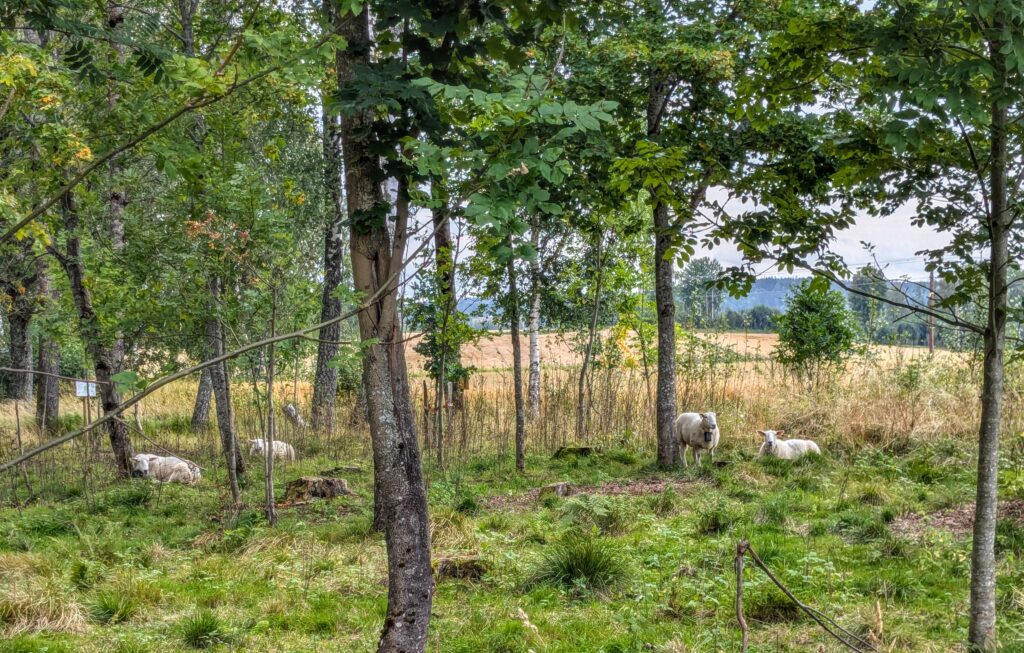
Behind the mound is a nice picnic area being used by these sheep!

And in front of the mound is this small pond. I waded out to the raft and enjoyed a few minutes of peace and relaxation!
August 27 To Jessheim (Day 335)
We had a late morning, not needing to get to the train station until after 11. We walked through town, past the unassuming entrance to Fjellhallen, behind construction fences.
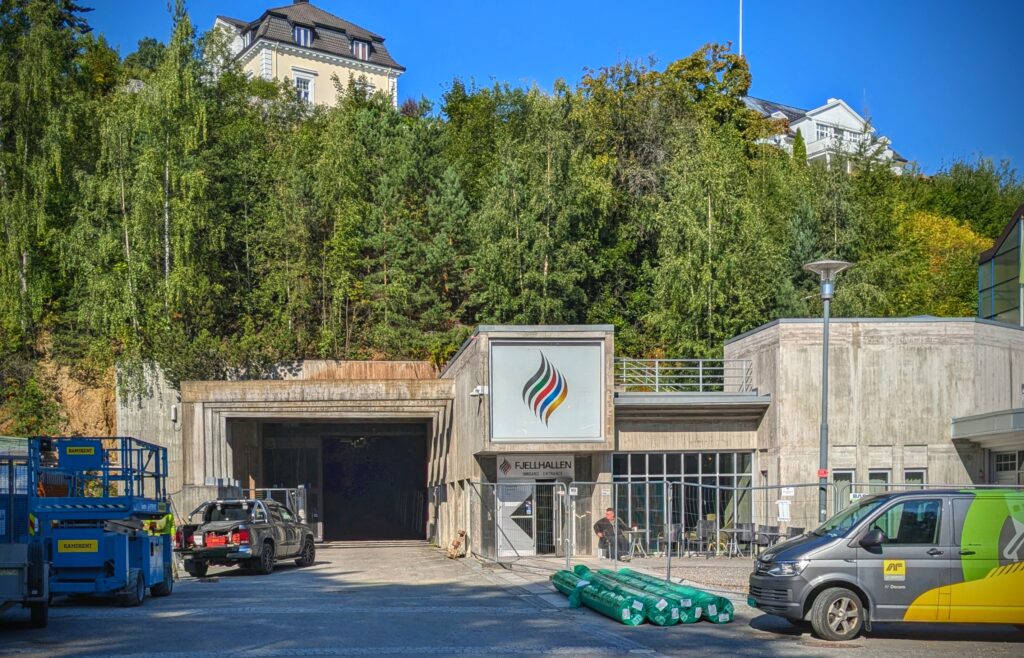
Hard to believe this is the entrance to the largest subterranean auditorium in the world!
We took our last train ride on our Eurail Pass today. We traveled 2 hours from Gjøvik south to Oslo, then caught a train for a 36 minute ride back north to Jessheim. The trip was through beautiful country, lush green Norwegian woods, following rushing rivers, past glacial lakes, but the scenery was rushing by so fast, and the train windows were dirty. Pictures would not do justice to the beauty. It must be a winter wonderland covered in snow! It got me thinking about the statue we saw in Lillehammer.

Outside the library in Lillehammer is this statue. Is it a Viking ‘berserker’ kidnapping a child? Is it a Norse God delivering a baby?
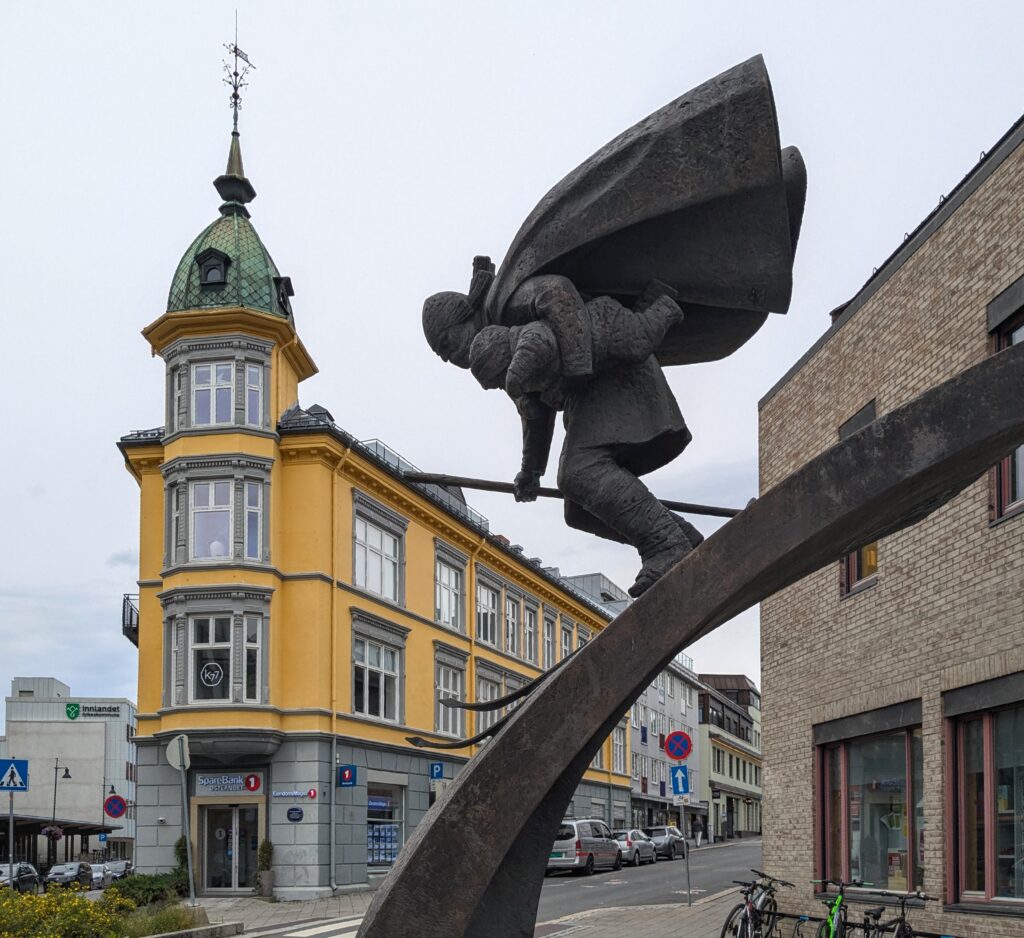
Translating the information provided, it is a ‘Birkebeiner’ known for transporting “the one-year-old Haakon Haakonsson, an heir to the Norwegian throne, safely from Lillehammer to Østerdalen to Trondheim, a long and perilous journey through treacherous mountains and forests” to save him from the opposing contender to the throne.
The Birkebeiners were a rebellious political party during the 110 year long civil war era in Norway, from to 1130 to 1240. The name has its origins in propaganda from the established party that the rebels were so poor that they made their shoes of birch bark, ‘birkebeiner’ translating to ‘birch bones’. Although originally derogatory, the opposition adopted the Birkebeiner name for themselves, and continued using it after they came to power in 1184. The rescue of the infant Prince is commemorated now in cross country ski races around the country, and even in the US, occurring in Wisconsin, home to many Norwegian immigrants and their descendants! The American Birkebeiner is held in February in Hayward, WI.
August 26 Skibladner (Day 334)
We headed back to the downtown today to find a thrift store to donate some summer clothes we no longer want to pack around. Unfortunately the store we found will not open until tomorrow, so we went towards the lakefront. Previously we had looked for an iconic symbol of Lake Mjøsa, the Skibladner, “the world’s oldest paddle steamer in timetabled service”, but it was not at its mooring in Gjøvik at the time.

As we walked down a street towards the lake we passed this model in a window. I went inside to ask if I could take a picture, and it is the office of the company that manages the boat. On closer look, this is a LEGO Skibladner!
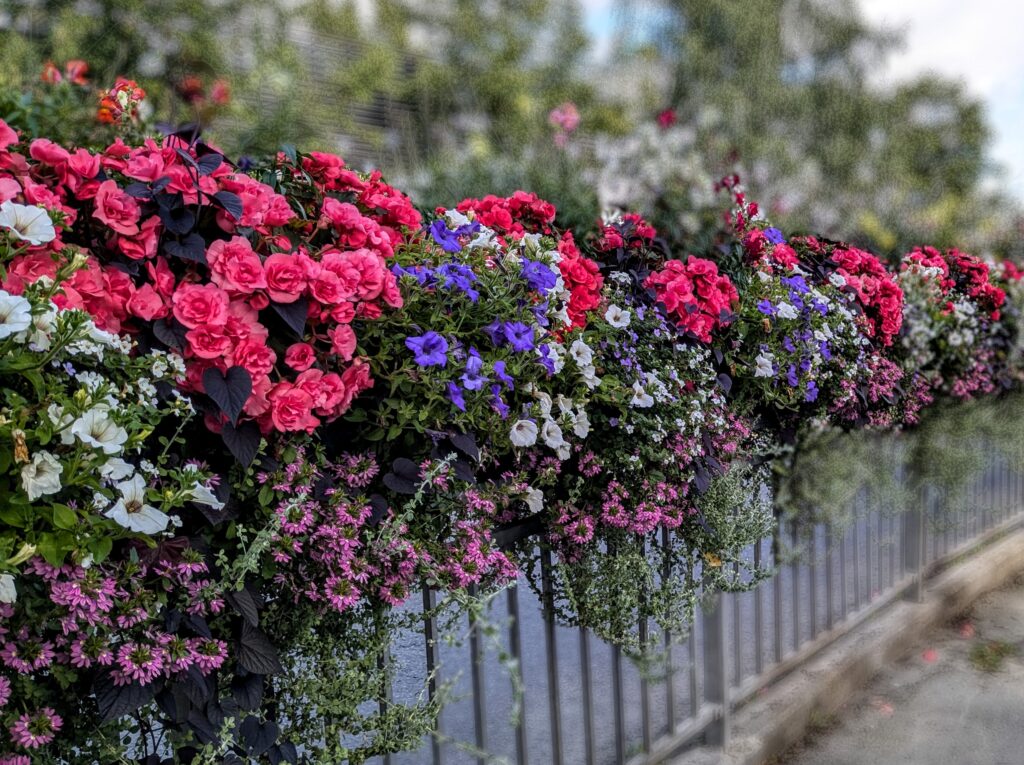
We continued to the lake past these beautiful flower boxes lining a street.

And there it was, docked and awaiting its next passengers.
Unfortunately the season for general passengers ended on August 18, it would need to be chartered for a private cruise until September when it is moored for the winter under a special glass-roofed boat house nearby!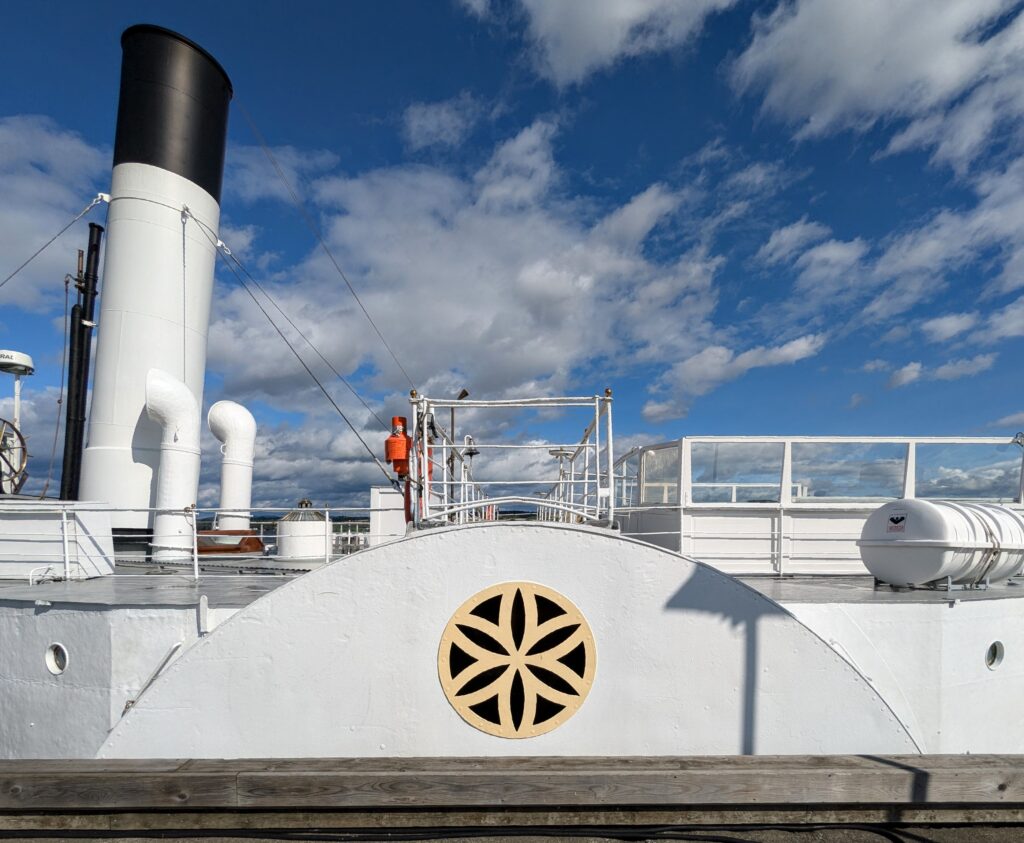 It’s a beautiful boat with wonderful symmetry, but much smaller than we expected!
It’s a beautiful boat with wonderful symmetry, but much smaller than we expected!

We have passed this building almost every time we’ve gone downtown and I finally got a picture of it. It extends almost a full block behind this double cornered entrance. I just thought it is a beautiful building, very eclectic.
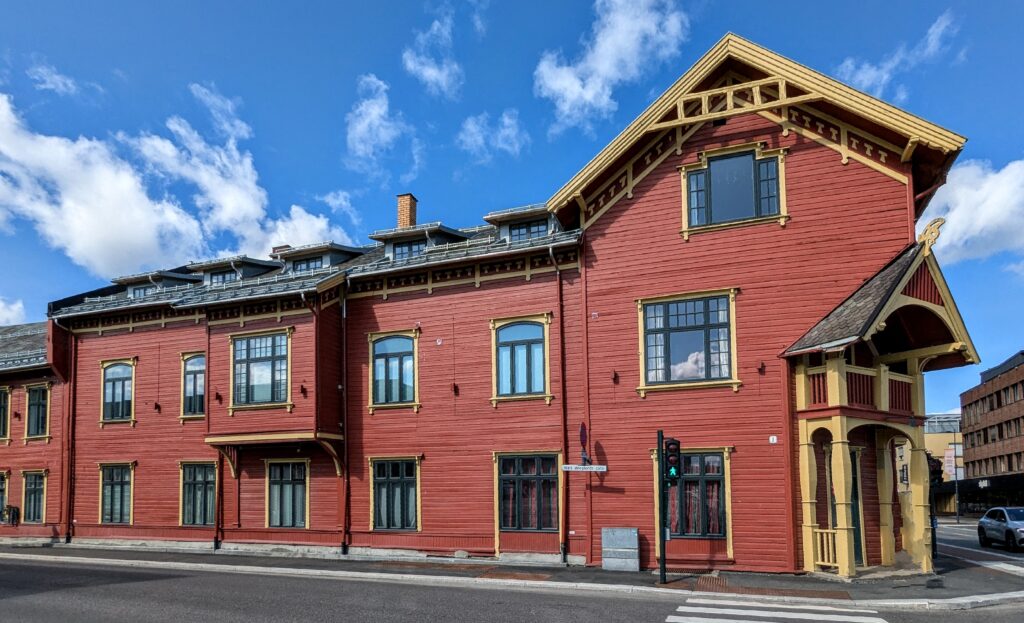
August 25 Eiktunet (Day 333)
Weather-wise, a beautiful day is predicted so we planned a walk into town to meander on the lakefront and wherever our fancies took us. We passed through the Gjøvik Gård and across the river to the industrial building that I thought was the glassworks factory or a distillery. Turns out it had been a distillery but now housed the Science Museum of Gjøvik. In the entrance hall is an exhibit of the table glass that was produced in Gjøvik from 1807 to 1843.
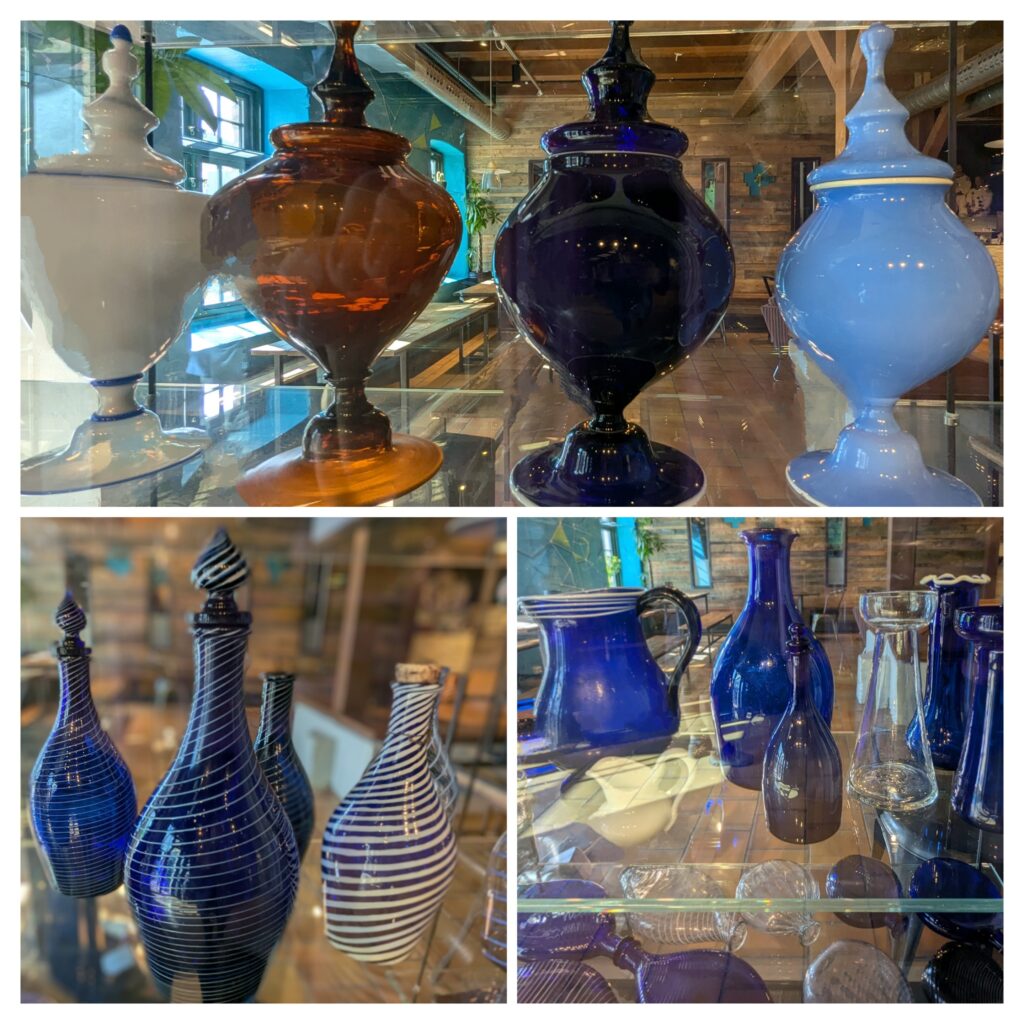
A beautiful assortment of table glass, behind glass, so lots of reflection. The factory was known for its ‘potpourri jars’ and its cobalt blue glasswares.
Downtown was deserted, the mall was closed as were most businesses and restaurants, so we decided to hike the almost 2 miles uphill to the open-air museum overlooking town and Mjøsa lake. The museum, ‘Eiktunet‘, translates to ‘the oak grove’ in english and is pronounced ‘Ike-tuna’. It consists of 33 buildings gathered from all around the area representing a rural community of the 18th and 19th centuries. As we ascended from the downtown streets then past apartment buildings we passed Fjellhallen, Gjøvik’s Olympic Cavern Hall, unbeknownst to us due to construction blocking the entrance and detouring us around the buildings. It is the world’s largest underground public use arena built as the hockey venue for the 1994 Winter Olympics based in Lillehammer! We had no clue as to it’s size because it was built into the mountain above town! Hiking further up through the neighborhood of single family houses on the hillside, we passed a small ski slope with a chair lift. You can truly say you ski down to the ski lift from your house!
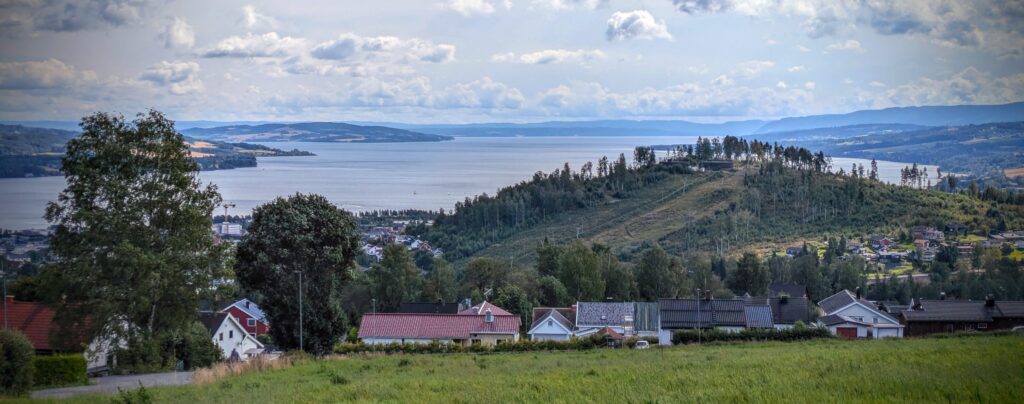
We walked up from the ski slope and looked back at an expansive view of the lake.
We reached Eiktunet museum and were eager to wander around all the old buildings, but we were surprised to find out that today it was closed to the general public for a special sold-out event.
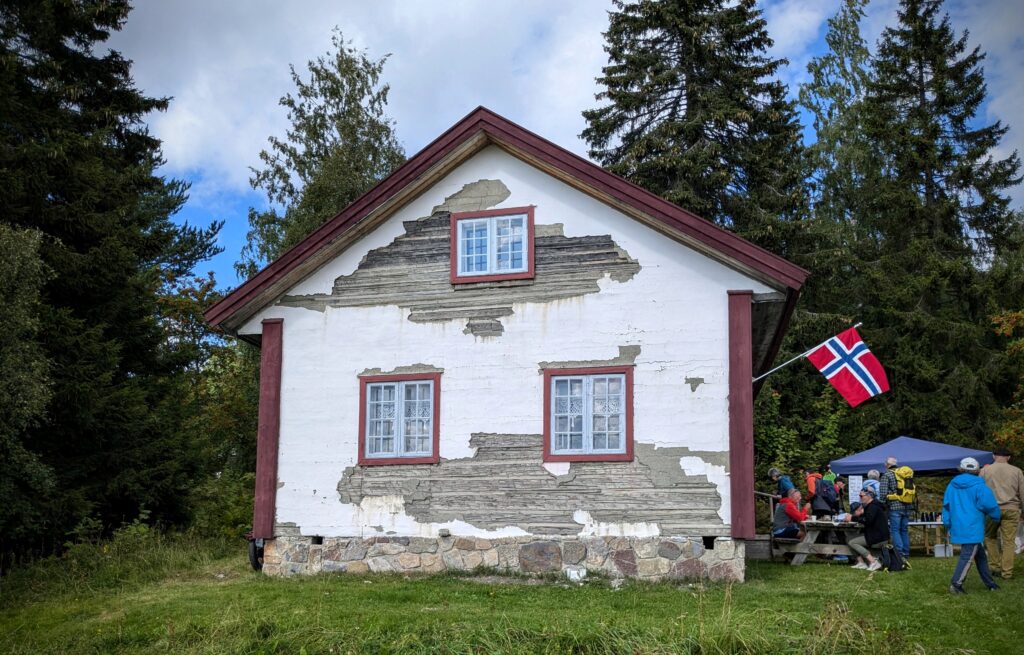
The only building we saw, from outside the fence near the entrance!
Bummer! We found a nearby picnic bench and had our sandwiches we had brought along. But all our effort hiking up the hill was not lost, there is a huge public park crowning the hill, and it seems that is were everybody from town decided to come enjoy the day, just like us! There are trails crisscrossing the hill, through the woods, along streams, over open fields where people (and their dogs) were picking wild blueberries, and past areas with educational signs and exercise suggestions and equipment!
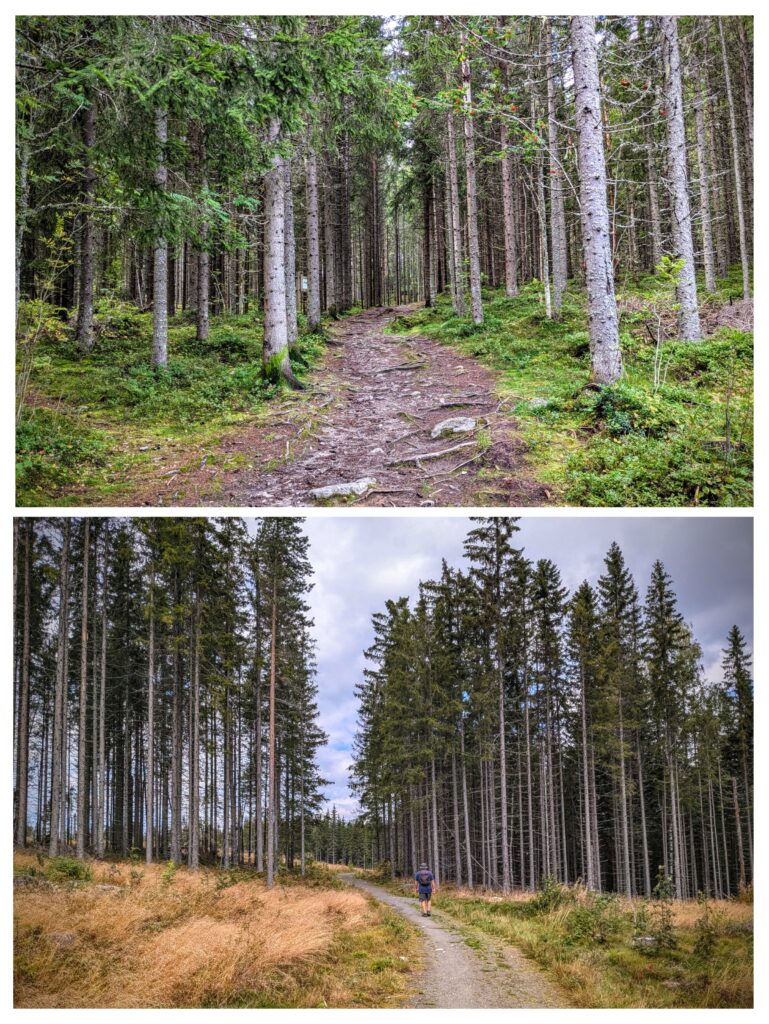
“Isn’t it good, Norwegian wood”
It was great seeing the families, groups of young kids, older couples, all walking or biking around the area, all respectful of each other and enjoying being outside!

Besides blueberries we saw a few people picking mushrooms which were everywhere! The top picture has a large mushroom at the base of a huge ant hill!
As we headed back down the hill, around the back of the ski slope, we had great views o the lake below us, but our pictures did not do it justice! We did see two impressive sites as we left the park and started walking through the residential areas.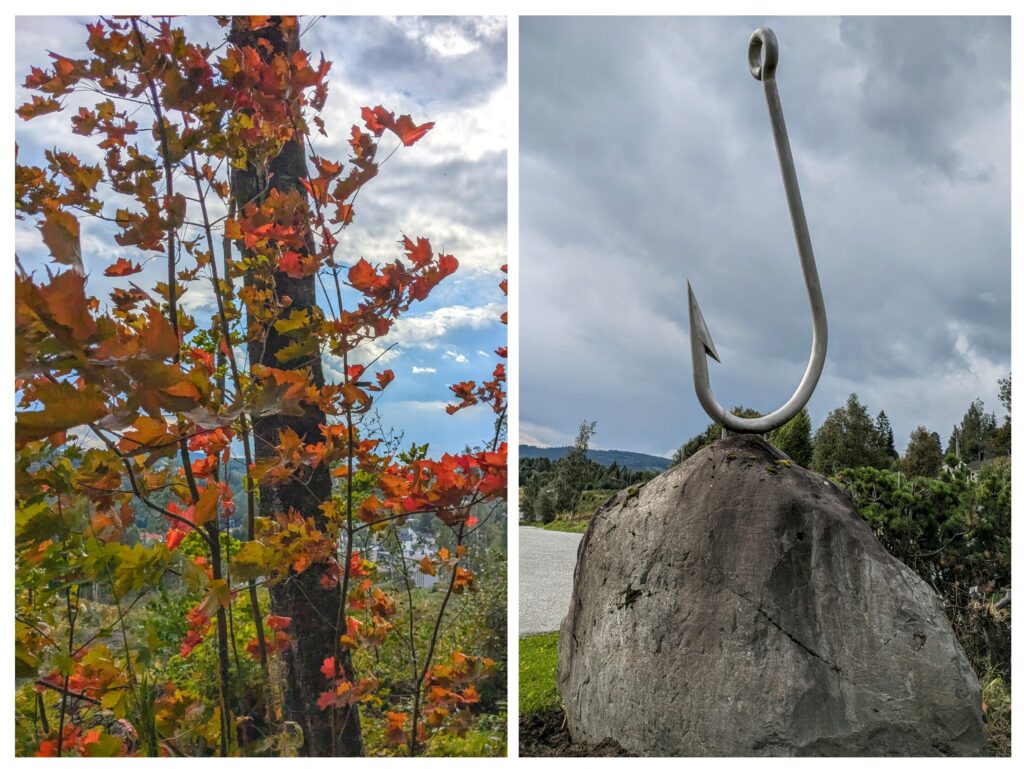
The colors of autumn are becoming more apparent, and fishhooks are important to Gjøvik based on this huge sculpture of a fishhook! It turns out that Gjøvik is the original home of O. Mustad & Søn, a steel wire products manufacturer who specializes in fishooks. This sculpture, and one of the founder’s son Hans Mustad across the street, are in front of the companies manufacturing campus, now a diversified industrial park, but still corporate home of the company.
August 24 Gjøvik gård (Day 332)
Another walk down to the waterfront, earlier today in order to hopefully avoid the predicted afternoon rain! We wandered through the big park near the ‘downtown’ area, along the Hunnselva river, the source of power to energize the Gjøvik Glassworks, established in 1807 by Caspar Kauffeldt, which spurred early growth and diversified the economy. The park, Gjøvik Gård, was Kauffeldt’s residence and ‘gentleman’s farm’.

The park around the residence.
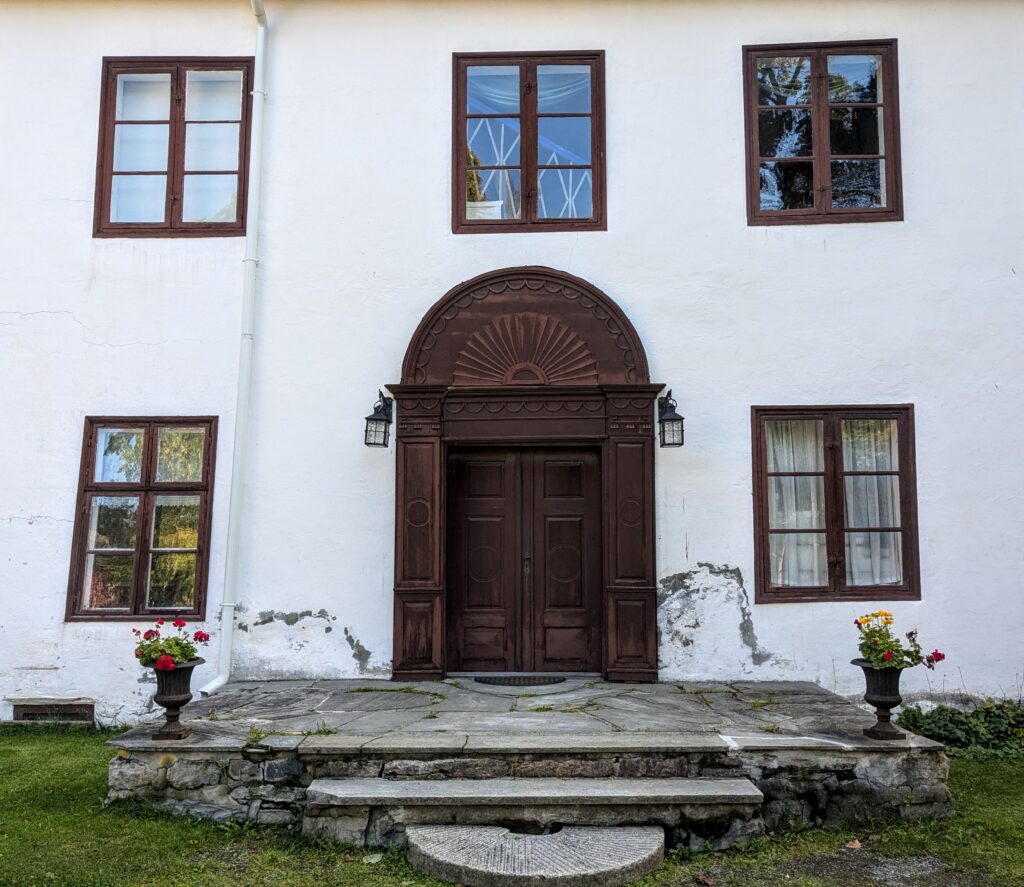
The front of the main residence, built in 1810.
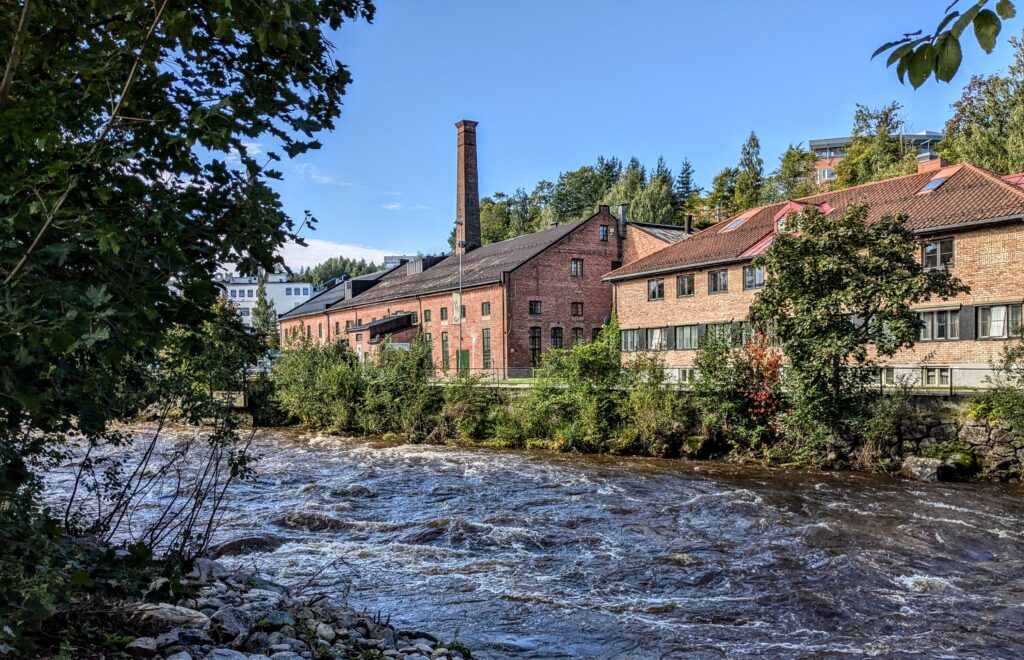
The glassworks (or maybe a distillery?) across the river from the park.

A mural highlighting the glassblowers who were the backbone of the glassworks.

The view looking down towards town and Mjøsa lake on our way back to the B&B.













 It’s a beautiful boat with wonderful symmetry, but much smaller than we expected!
It’s a beautiful boat with wonderful symmetry, but much smaller than we expected!











